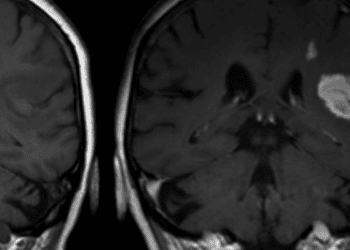Diacylglycerol kinase α is a potential target for X-linked lymphoproliferative disease treatment [PreClinical]
1. Diacylglyerol kinase α (DGKα) inhibitors R59949 and R59022 partially restored restimulation-induced cell death (RICD) in activated T cells from patients with X-linked lymphoproliferative disease (XLP-1).
2. In a mouse model of XLP-1, treatment with R59022 led to improved RICD as measured by fewer inflammatory lesions in the liver and overall decreased activation of the immune system relative to control treatment.
Evidence Rating Level: 2 (Good)
Study Rundown: XLP-1 is a congenital immune disorder that causes the accumulation of activated T cells in response Epstein-Barr virus (EBV) infections. Due in part to the ineffective clearance of T cells through the RICD process, this disease leads to tissue damage caused by the excessive infiltration of immune cells into organs such as the liver and bone marrow. Because the protein that regulates DGKα levels is defective in XLP-1 patients, the authors of this study investigated DGKα inhibitors as potential therapeutics to improve RICD in XLP-1 T cells.
Initial studies in vitro demonstrated that when XLP-1 patient-derived T cells were modified to no longer express DGKα or were treated with R59949 or R59022 to pharmacologically inhibit DGKα, cell death increased upon restimulation. To model EBV infection in XLP-1 patients, the authors utilized a genetic murine model of XLP-1 in which mice were infected with lymphocytic choriomeningitis virus (LCMV). XLP-1 mice treated with R59022 showed a decrease in LCMV-specific active T cells, hepatic inflammatory lesions, and serum levels of the proinflammatory protein interferon gamma (IFNγ). Notably, treatment did not affect the ability of mice to resolve the viral infection over an eight-day period.
While the authors did not report on the effects of DGKα inhibition in other immune cell types relevant in XLP-1, this work demonstrates the possible therapeutic benefit of using DGKα inhibitors to restore the RICD regulatory mechanism in the T cells of XLP-1 patients. Further studies will need to address the ability of DGKα inhibitors to improve overall survival, as overexpansion of T cells is often fatal in XLP-1 patients with EBV infection.
Click to read the study in Science Translational Medicine
Relevant Reading: SAP gene transfer restores cellular and humoral immune function in a murine model of X-linked lymphoproliferative disease
In-Depth [animal study]: The authors first established the potential to improve RICD by targeting DGKα in T cells using in vitro studies. Small-interfering RNA was utilized to decrease the expression of DGKα in patient-derived T cells. The DGKα loss significantly increased the rate of T cell death upon stimulation with 50-100 ng/mL of the anti-CD3 antibody OKT3 (p<0.016). Pharmacological inhibition of DGKα activity by R59949 or R59022 demonstrated a similar trend of enhanced cell death.
To test the effect of DGKα inhibition on immune cell function in vivo, Sh2d1a−⁄− mice were used as a model of XLP-1. Four days after infection with 2 × 105 plaque-forming units of LCMV, mice (n=6 to 10 in each cohort) were treated twice a day with 2 mg/kg body weight of R59022 via intraperitoneal injection. Eight days after infection, spleens and livers were collected from wild-type and XLP-1 mice, treated and untreated, for analysis.
Treated XLP-1 mice showed a significant decrease in the absolute number of splenic and hepatic CD8+ T cells specific to LCMV virus (p=0.0006 and 0.0009, respectively), whereas wild-type mice were unaffected by treatment. Histology samples of liver tissue from XLP-1 mice were analyzed, and compared to the untreated group, treatment with inhibitor led to a significant decrease in the number and size of infiltration lesions containing greater than 8 lymphocytes (p<0.0001). Enzyme linked immunosorbent assays showed a significant decrease in serum levels of IFNγ in treated XLP-1 mice compared to untreated mice (p=0.0013). Nonetheless, R59022-treated mice showed undetectable viral loads in the spleen and liver at the end of the 8-day experimental period.
Image: CC/Lisa Gross
©2016 2 Minute Medicine, Inc. All rights reserved. No works may be reproduced without expressed written consent from 2 Minute Medicine, Inc. Inquire about licensing here. No article should be construed as medical advice and is not intended as such by the authors or by 2 Minute Medicine, Inc.







